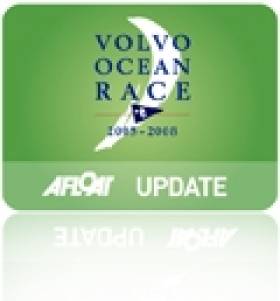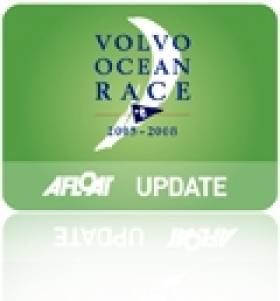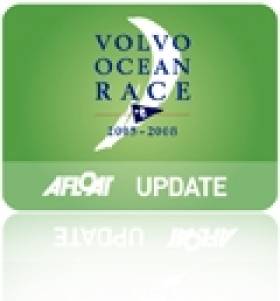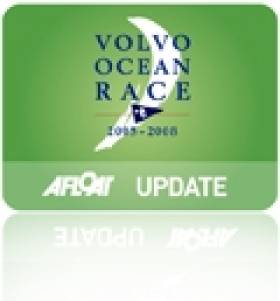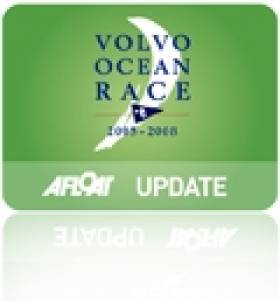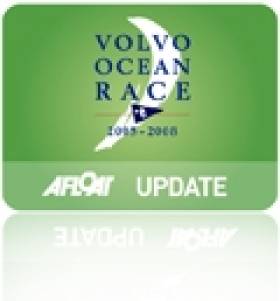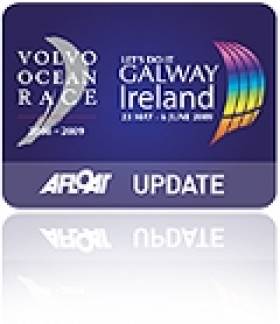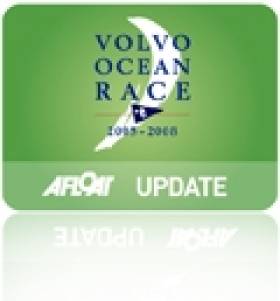Displaying items by tag: Volvo Ocean Race
First Candidates For All-Female VOR Team Sail to Lanzarote
#VOR - The first candidates for places on Team SCA's all-female team for the next edition of the Volvo Ocean Race are currently sailing on a training leg from Southampton to Lanzarote.
The Volvo Ocean Race website spoke to one of the hopefuls, Vendee Globe veteran Sam Davies, who described the team's plans to field the first women-only team in the VOR as "an amazing opportunity for me and woman's sailing in general, especially for women ocean racers."
She's joined on the VOR 70 training vessel - which sports the team's recently unveiled livery ahead of the completion of their VOR 65 yacht - by fellow Brit sailor Annie Lush, Carolijn Brouwer and Klaartje Zuiderbaan from the Netherlands, Jeanne Gregoire from France, and Liz Wardley and Stacey Jackson from Australia.
Davies said of the team selection that it's "a two-way process... the managers are looking at all of us and we're testing it out to see if it is really what we want to do."
Team SCA managing director Richard Brisus said of the first trainee voyage to the team's base at Puerto Calero: "We have set out to work with the world’s best female offshore sailors and create a strong group of women that also has the ability to work well together as a high-performing team."
A second group of candidates will head out to sea shortly, and Team SCA coach Magnus Olsson said it "would be fantastic if we could find our team from these two groups.
“They are a remarkable group of women and each brings a very high level of skill sets to a potential team."
Volvo Ocean Race Finale Honours Go To Gothenburg For 2015
#VOR - Despite hopes within Galway after last summer's successful conclusion to the Volvo Ocean Race, it's been announced that the next edition of the round-the-world yachting challenge will have its finish line in Sweden.
Gothenburg was chosen last week as the final stop for the 12th running of the Volvo Ocean Race in 2014-15. It will be the second time the city - also the headquarters of the title sponsor - has hosted the race after the 2005-06 running.
"Gothenburg is the perfect place to finish a global event of this stature," said Volvo Ocean Race CEO Knut Frostad. "It's great to know that after sailing tens of thousands of miles around the world we'll be coming to a host port with all the facilities and knowhow to make this a great event, and the history to make it feel like a real homecoming."
The deal announced on Friday also secures Gothenburg's place on the race route for the 13th edition of the race.
It is the fifth of the hosts port announced so far, after the race start at Alicante in Spain, two stopovers in Brazil and a return visit to Auckland in New Zealand.
According to Galway Bay FM, the City of the Tribes is still in the running among 100 host cities that have registered an interest to host the VOR on its next sail around the world.
This is despite claims that last summer's finale organiser Let's Do It Global could be faced with liquidation due to failure to meet its outstanding debts from the event, said to amount to almost half a million euro.
As previously reported on Afloat.ie, Dun Laoghaire may consider its own tender to host the race to cash in on the success of the event for local business and tourism in Galway last year.
Volvo Ocean Race Veteran Hails New One Design
#VOR - SailRacing Magazine recently sat down with Volvo Ocean Race veteran Neil Cox to get his views on the new design VOR 65 that will sail in the next edition of the round-the-world race next year.
A project consultant for the early stages of the build process, Cox - previously a shore manager for the PUMA and CAMPER crews - says the designers started from scratch "with a blank canvas" as opposed to previous designs based on iterations of "the Volvo rule".
He also enthuses about the change to one design racing in the VOR, which "means the greatest speed advantage will come from being able to push the boat harder than anyone else".
SailRacing Magazine has much more on the story HERE.
Meanwhile, TVNZ reports that Auckland in New Zealand has been announced as the latest stopover port for the 2014-15 edition of the global yachting challenge.
Volvo Ocean Race chief Knut Frostad described the race's return to New Zealand in 2015 and again in 2018 as a "no brainer" after last year's visit to the country's largest city on the Southern Ocean leg.
Two stopovers in Brazil were previously unveiled for the next edition of the Volvo Ocean Race, the most recent of which enjoyed a memorable conclusion in Galway last summer.
Lightness, Strength and Rigidity Key to New VOR 65 Design
#VOR - In the latest video update following the construction of the Volvo Ocean Race's new one-design yacht, VOR expert Rick Deppe travels to the Decision plant in Lausanne, Switzerland to take a look at the production of the boat's internal structure.
The new footage shows the 'sandwich' construction of the lightweight internal frame of foam and carbon fibre which will give the yachts the strength and rigidity that will make them both fast and safe on the open sea.
Previously the series visited the USA, Italy and France for an all-round catch-up on the progress of the new VOR 65 design.
Fans of the Volvo Ocean Race should expect a "very forward thinking" design when the finished boat is finally unveiled ahead of the next edition of the round-the-world race.
As reported on Afloat.ie last week, Team SCA have unveiled the livery for their VOR 65 which they intend to launch when ready to race later this year.
Brazil Now A Double Host for 2014-15 Volvo Ocean Race
#VOR - Brazil will now have two stops on the route for the 12th edition of the Volvo Ocean Race as Itajaí joins the previously announced Recife on the list of host ports.
Itajaí, in the state of Santa Catarina, staged a memorable stopover in the 2011-12 edition with huge crowds packing the Race Village throughout, and the port’s return to the route means the south of Brazil is joining the north east in the race.
As previously reported on Afloat.ie, a boat backed by the state of Pernambuco was confirmed at last week’s announcement which race organisers say will ensure a distinct Brazilian flavour for the race's 12th edition in 2014-15, at a time when the focus of world sport will be on the country.
"Making two stops in Brazil makes perfect sense at a time when the country will be the beating heart of sport between soccer's World Cup in 2014 and the Rio Olympic Games in 2016," said Volvo Ocean Race CEO Knut Frostad.
"We are thrilled to be going back to Itajaí, which proved to be one of the most successful stopovers of the last edition with a rhythm all of its own.
"We had huge numbers of fans in attendance on all the key dates and with the support of the city and the region we're looking forward to breaking those records next time."
Once again, Itajaí will provide the long awaited finish line for the teams following their rounding of the iconic Cape Horn in the Southern Ocean.
"The leg through the Southern Ocean, around Cape Horn and on to Brazil, was an instant classic in the last edition," said Volvo Ocean Race COO Tom Touber, who made the announcement at the Castelo Montemar in Itajaí today (22 January).
"Going twice now to the vast, diverse and sports-mad country of Brazil is a privilege for us."
Speaking at the announcement, Itajaí mayor Jandir Bellini added: "Hosting the Volvo Ocean Race once again is proof that Itajaí is capable of staging the biggest events in the world.
"It is our goal to confirm Itajaí as a national capital of sailing."
Exact dates of the Itajaí stopover will be announced next month. The remainder of the route for the 12th edition of the Volvo Ocean race will be revealed over the coming weeks.
Volvo Ocean Race Returns to Brazil for 2014-15
#VOR - Organisers of the Volvo Ocean Race have announced that the Brazilian state of Pernambuco will enter a team in the next edition of the round-the-world offshore challenge in 2014-15.
In addition, its capital city of Recife will be the first stopover port along the race route, which starts in Alicante in the second half of next year.
The Recife team is only the second publicly announced team for the 12th edition of the VOR, following the SCA all-women's team announced last August.
Details about the stopover and the team, including the identity of the skipper, will be announced in the coming weeks.
“[The] announcement of the Pernambuco team and Recife stopover are fantastic news for the race,” said Volvo Ocean Race CEO Knut Frostad. “I’m delighted to see the Race strengthen our ties with Brazil, Recife and Pernambuco in this way.
"Coming to Recife at the end of Leg 1 means there will be a lot of attention on this great city and having a Brazilian team in the race will be fantastic for fans across the country."
The decision to make Leg 1 of the route from Alicante to Recife means the VOR will be visiting Brazil in one of the biggest sporting eras in the nation's history – just a few months after the country hosts the 2014 Fifa World Cup and less than two years before the Olympic Games in Rio.
Recife was one of over 80 ports to express an interest in hosting the race when the bid process was launched in 2012. The deal announced yesterday will see Recife host the race for the next two editions.
The last Brazilian team to enter the Volvo Ocean Race was Brasil 1 in 2005-06. Torben Grael was the skipper and Knut Frostad, now the Volvo Ocean Race's CEO, featured as a crew member on some of the legs. The Brazilian campaign proved to be a big success and generated great interest worldwide and in the media. Grael went on to win the Volvo Ocean Race as skipper of Ericsson 4 in 2008-09.
The Volvo Ocean Race's links with Brazil date back to 1973, when the first edition of what was then known as the Whitbread Round the World Race stopped at Rio de Janeiro.
The race also visited Rio in the second edition in 1977-78 and again in 2001-02, 2005-06 and 2008-09. In 1997-98 the race stopped at São Sebastião and in the last edition in 2011-12, Itajaí was a host port.
Meanwhile, Team SCA have unveiled the livery for their VOR 65 new design when it is launched and ready to race later this year.
As previously reported on Afloat.ie, the new design VOR 65 - priced at €4.5 million, about 20% less expensive than the 70-footer that ended its run in Galway last summer - was developed with the idea of reducing the costs of competing in the gruelling round-the-world yacht race.
The official VOR website has images of the SCA livery, with nature-inspired graphics and colours designed to reflect the eco-friendly values of the title sponsor, global hygiene company SCA.
At the beginning of February, a number of Team SCA women crew candidates will leave Southampton on a first test sail together with several leading off-shore coaches.
Team SCA have not yet revealed the identity of any of the crew, including the skipper.
#VOR - The Volvo Ocean Race has launched its search for a team of onboard reporters for the 2014-2015 edition of the epic round-the-world challenge.
For the third consecutive edition, each team taking part in sailing's biggest offshore race will have on board an embedded multimedia reporter, formerly known as an MCM.
For the 2014-15 edition, each onboard reporter must be approved by the Volvo Ocean Race in a step introduced to make sure all teams make best use of the enhanced media capabilities of the new one-design Volvo Ocean 65.
"We're starting the hunt for proven media professionals to tell the real story of this extraordinary race," said director of communications Jon Bramley. "We need people who can be at the top of their game despite conditions that test even the world's best professional sailors to the core."
Selected candidates will be required to spend five weeks at the Volvo Ocean Race headquarters in Alicante, Spain for training. Those approved will then be matched up with one of the teams for the pre-race period plus the event itself.
Interested candidates should send a CV and covering letter to [email protected]. More details on the job can be found at www.volvooceanrace.com.
'Bailout' Sanctioned for Galway VOR Stopover
#VOR - The Galway City Tribune reports that Taoiseach Enda Kenny has sanctioned a bailout for outstanding debts owed by the organisers of this summer's Volvo Ocean Race finale in Galway.
Minister for Tourism and Sport Leo Varadkar had previously ruled out any Government assistance to cover the €400,000 in debts owed by Let's Do It Global to numerous suppliers.
Let's Do It Global was subsequently moved to declare that a decision on bidding to host a third stopover is "postponed" while it concentrated on settling with its creditors.
But now unconfirmed reports suggest that Government funding will be provided in January to cover €360,000 of the debt.
Galway West TD Brian Walsh told the Tribune he is "confident that the issue in relation to debts will be sorted out, and that the creditors - many of whom are small businesses - will be paid."
Though it is unclear when Galway will be prepared to tender for a third hosting of the round-the-world yacht race, organisers for Dun Laoghaire have recently announced their intention to bid for the 2016 race - and cash in on the success of the event in the City of the Tribes this year.
Dun Laoghaire May Bid for Volvo Ocean Race Stopover
#VOR - The Irish Independent reports that Dun Laoghaire is considering a tender for the Volvo Ocean Race to cash in on the success of the event in Galway this summer.
Despite attracting nearly one million spectators to the City of the Tribes and brining tens of millions of euro into the local economy, Galway is not expected to bid for the next edition of the race in 2014-2015, with race organisers Let's Do It Global citing the need to concentrate on paying off its outstanding debts to suppliers.
That decision paves the way for Dun Laoghaire to table its own bid for the round-the-world yacht race in 2016, after Dun Laoghaire-Rathdown County Council passed a motion to enter consultations with Fáilte Ireland.
With both Fáilte Ireland and the Government potentially stepping up €5 million of the expected €8 million total cost, Dun Laoghaire's hosting of a VOR stopover would be predicated on raising the remaining €3 million.
Councillor John Bailey, who proposed the motion, told the Evening Herald in June: "We need to bring the 2016 race to Dun Laoghaire. It's too late to apply for 2014, but we could make it a great success in 2016."
It's not the first time Dun Laoghaire-Rathdown councillors have eyed the race.
In 2010 Cllr Gearóid O'Keeffe, seconded by Cllr Jim O'Leary, proposed that the council invite Volvo Ocean Race organisers "to designate Dún Laoghaire as a port of call".
However, the south Dublin town's gestures towards hosting this year's edition of the race were scuppered by a lack of available funding, and a tender was never submitted.
A council spokesperson said at the time that the costs associated with hosting the event were "substantial" and that the council wasn't "in a position to underwrite these costs".
Dun Laoghaire also reportedly failed to bid for the VOR in 2009, which sparked a row among councillors after it emerged that Galway's staging of the race that year generated €55 million for the city's economy.
Over 1 Billion Global Audience for Volvo Ocean Race Galway
#vor – A new report from the J.E. Cairnes School of Business & Economics at NUI Galway reveals that the Volvo Ocean Race Finale (VOR) which took place in Galway city earlier this year, having hosted a stopover for the Race in 2009, was worth €60.5 million to the Irish economy. Over 500,000 visitors attended events during the festival period from 30 June to 8 July 2012, with 16% of those coming from outside of Ireland.
The 2011-12 Volvo Ocean Race lasted for nine months and covered 39,270 nautical miles. The boats circumnavigated the globe, visiting eight stopover ports before finishing in Galway. The participants sailed through four oceans and visited ports in five continents, making it the toughest sailing event in the world. Hundreds of thousands of spectators visited the race villages in the participating ports, while millions tuned in via numerous media channels.
The report, An Economic Assessment of the Volvo Ocean Race Finale, Galway 2012, takes an in-depth scientific examination of the economic impact of the event in Galway over the nine day period. It also reports on the extra-economic benefits of the VOR finale which saw an investment by organisers and Galway City of €7.6 million.
Speaking of the findings, Dr Patrick Collins of NUI Galway's Whitaker Institute said: "For nine days and nights, Galway City became the focal point of one of the most highly regarded international sporting events, supported by over 275 free events around the city. The magnitude of the event in terms of the relatively small economy of the Galway area was exceptional."
For the duration of the event the harbour area of Galway city was transformed into a hub of activity in both the commercial and entertainment spheres. The addition of the 'Global Village', a unique expo highlighting the best of Irish business, education and craft, brought a new feel and focus to the event. The hosting of showcases under the pillars of marine, innovation, green and food, was a platform for the city and the region to display its unique strengths.
The report, which was launched today (26 November) at NUI Galway, identifies key questions on the event's economic impact. Findings reveal the direct expenditure of €35.5 million and indirect spend during the festival period of €25 million giving an overall economic impact of €60.5 million.
The hospitality industries gained the most in terms of relative increase in revenue. In particular the Bar/Lounge sector enjoyed a significant boost over the course of the event with turnover showing a 50% increase across the sector. However, a quarter of local businesses found their business was negatively affected by the Race as most of the economic benefit was located in the areas surrounding the event and particularly by the hospitality industries.
Dr Patrick Collins explains: "What becomes immediately obvious when we look at the relative change in turnover spatially is the tight geography of benefit. What might be termed the 'honey-pot' effect of the Race and Global Villages are obvious with adjacent businesses in particular sectors gaining extra revenue. Revenue gains were highly differentiated by location and business sector. "
Positive employment figures showed an increase in numbers employed over the course of the event, with over 70% of these in the hospitality industry and more than 80% of this located in Galway city centre. However, these employment gains were of a temporary nature - of those hired on a full or part-time basis, 42% were for the duration of the festival only, and only 7% of the new employees lasting beyond a three month period.
The report states that approximately 800,000 visits were recorded to the Race Village and the Global Village over the duration of the Volvo Ocean Race festival and 97% of these race attendees rated their Galway experience as positive.
According to Dr Emer Mulligan, Head of the J.E. Cairnes School of Business and Economics, NUI Galway: "The Volvo Ocean Race finale focused the attention of a global audience of over one billion on the city of Galway for the duration of the event. This kind of attention brings with it massive opportunities for the promotion of the city and its businesses."
Extra economic impacts examined and included in the report include results on how businesses and attendees during the Volvo Ocean Race Finale also cited non-economic aspects of the festival. More than 1,500 volunteers took part in the organisation of the Volvo Ocean Race finale in Galway. They contributed thousands of hours to cater for more than 500,000 visitors to the nine-day event.
Dr Mulligan added: "Looking beyond the economic helps us identify the ancillary benefits and costs of hosting an international event of this scale. Economic impact events of this magnitude are significant but it is incumbent on any assessment to incorporate the extra economic impacts such as boost of morale for the host city and the upsurge of community spirit experienced by all. While the commercial emphasis was obvious, the event did not lose the key element which was held most precious during the 2009 stopover, the family-friendly community spirit."
The report was compiled by Dr Patrick Collins, Dr Stephen Hynes and Dr Emer Mulligan of NUI Galway on behalf of Let's Do It Global.




























